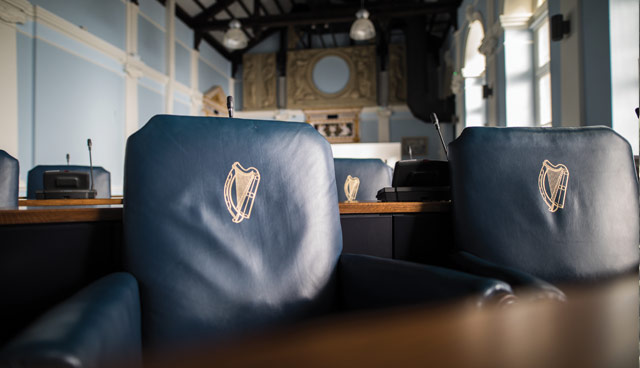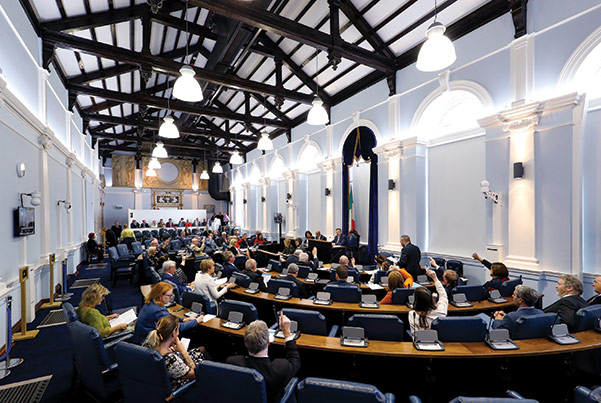The future of the Seanad


The continued existence of Seanad Éireann makes Ireland atypical. Globally, the majority of parliaments are now unicameral and of those which are bicameral, only the Seanad and the Slovenian National Council are intended to represent vocational interests. eolas explores its historical nuances and recommendations for its future.
Seanad Éireann, the second chamber of the Irish legislature is comprised of 60 members. Of these, 11 are nominated by the Taoiseach, six are elected by graduates of the University of Dublin (Trinity College) and the National University of Ireland and 43 are elected to one of five vocational panels. From each Vocational Panel, no more than 11 and no less than five senators can be elected. Each candidate must be nominated to a panel either by any four members of the Oireachtas or by a registered and relevant nominating body. The annually revised Register of Nominating Bodies is maintained by the Clerk of the Seanad.
The modern Seanad, established by Bunreacht na hÉireann in 1937, is a successor to the Senate of the Parliament of Southern Ireland (1920-22), which met only once and was boycotted by nationalist Ireland, and also the Seanad in the Oireachtas of the Irish Free State (1922-36).
Composition
Article 82 of the Constitution of the Irish Free State determined that the then President of the Executive Council (a forerunner to the office of Taoiseach), WT Cosgrave, should nominate 30 members to the Seanad and that he should “have special regard to the providing of representation for groups or parties not then adequately represented in Dáil Éireann” (a promise made by Arthur Griffith before his death).
This year, in his first speech before the Seanad, An Taoiseach Leo Varadkar noted the diverse composition of the first Seanad and the “deliberate effort to ensure that minority views were represented, especially Protestant and unionist voices”.
In all, 16 unionists ranked among Cosgrave’s nominees. A total of seven peers, seven knights, five baronets and a countess sat in the first Seanad. Indeed, the first Cathaoirleach, James Campbell or Baron Glenavy, was a former Lord Chief Justice and Lord Chancellor of Ireland. By the first Seanad election in 1925, only a quarter of the electorate turned out to vote amid an anti-Treaty boycott. In the event, only eight of the senators nominated by Cosgrave in 1922 were returned. Most of this unionist representation was supplanted by the pro-Treaty Cumann na nGaedheal, the Labour Party and the Farmers’ Party.
Direct election, guaranteed under the Free State Constitution, which indicated that, “All citizens of the Irish Free State (Saorstát Éireann) without distinction of sex who have reached the age of 30 years and who comply with the provisions of the prevailing electoral laws, shall have the right to vote for members of Seanad Éireann”, inadvertently stripped the second chamber of its intended purpose.
By 1934, after Fianna Fáil’s rise to power, de Valera had abolished the Free State Seanad. However, in 1937 a new Seanad, with an intentionally emasculated status and based on the vocationalism of contemporary Catholic teaching, was enshrined in the Constitution of Ireland.
The Constitution restored the Upper House, with its members envisioned as “persons having knowledge and practical experience” of either ‘National Language and Culture, Literature, Art, Education’; ‘Agriculture and Fisheries’; ‘Labour, whether organised or unorganised’; ‘Industry and Commerce’; or ‘Public Administration’. Vocational interests were intended to be at the forefront, yet, in practice, the Seanad, by its composition, is dominated by the government of the day with a majority that is bolstered by the Taoiseach’s nominations.
“The voices of Irish people around the world should also be represented and heard.”
Often the Seanad has been used as an ‘antechamber’ to blood aspiring parliamentarians or as a soft landing for failed prospective Dáil candidates. Indeed, the party-political nature of the Upper House has smothered the potential for the panels to be populated by genuinely vocational candidates. In 1970, Basil Chubb, “the father of political science in Ireland”, argued: “Naturally, the prestige of the Seanad suffers from the fact that, by and large, it is merely another selection of party politicians chosen in an unnecessarily complicated and not particularly democratic manner.”
Northern representation
Between 1982 and 2002, several taoisigh used their nominations to ensure Northern representation in the Upper House of the Oireachtas (though in 2007 and in 2011, then taoisigh Bertie Ahern and Enda Kenny declined to do so). Notable members appointed this way have included: John Robb; Seamus Mallon; Bríd Rodgers; Gordon Wilson; Edward Haughey; and Maurice Hayes. Meanwhile, Sam McAughtry was elected to the Industrial and Commercial Panel in 1996, Niall Ó Donnghaile was elected to the Administrative Panel as a Sinn Féin senator in 2016 and most recently, Ian Marshall was elected to the Agricultural Panel in 2018.
Speaking on previous attempts to ensure greater unionist representation, Seamus Mallon noted: “There has been a huge reluctance on unionists to take nominations to the Senate, that’s a fact of life.” This is reflected somewhat in the Belfast-based unionist News Letter, which described Marshall as “an atypical unionist” and suggested that he “faced some questions about his ‘unionist’ credentials, not having had any specific party-political experience”.
Regardless, the current Taoiseach has expressed support for the recommendation made in several major reports on reform which would ensure the election of senators from across the North’s political spectrum, to facilitate “an all-island dimension and provides different voices on issues which concern us all”. Likewise, he expressed his judgement that “the voices of Irish people around the world should also be represented and heard”. Such an extension of representation has previously been opposed, for instance by former Fianna Fáil Senator Ann Ormonde who, in 2004, argued: “I would not give them a hand out. I don’t mind having a representative here, but there should be no more than that.”
Functions
The primary function of the Upper House is the scrutiny, amendment and initiation of legislation. However, unlike its predecessor, in its current format the Seanad can delay a Bill passed by the Dáil for only 90 days (as opposed to 277 days) and cannot initiate a Money Bill (which it has only 21 days to consider). The Dáil can override the Seanad’s rejection of a Bill. However, the Seanad is co-equal with the Dáil in the event of presidential impeachment, the declaration of a state of emergency and the removal of a Supreme Court judge which each require joint Oireachtas approval.
Varadkar has stated that it’s “true role” is to act as a check and balance on the Dáil, but the extent to which the modern Seanad is restricted to an advisory and a revising role is exposed by the fact that it has not rejected a Bill passed in the Dáil since 1964.
Reform
In 2013, a Fine Gael-Labour Government proposal to abolish the Seanad was rejected by the electorate in a referendum, with 51.7 per cent voting against and 48.3 per cent voting in favour. Abolition was also supported by Sinn Féin while Fianna Fáil opted to back a commitment to reform. While Varadkar himself was a proponent of abolition, in light of the referendum he told the Seanad: “The people have spoken and the matter is now settled. It will not be revisited.” In total, since 1928, some 13 official reports recommending reform of the Seanad have been published.
A committee with an eight-month mandate to legislate for Seanad reform has now been established by An Taoiseach. The Committee will examine the recommendations contained in the 2015 Manning Report made by the Working Group on Seanad Reform which had been formed by the previous Taoiseach Enda Kenny. Indeed, the current Programme for Government commits to the Report’s implementation.

The stated principal objective of the Report is the “restructuring and reforming Seanad Éireann to bring it into line with international best practice for Second Houses of Parliament in the 21st Century”. The remit of the Working Group, chaired by former Senator Maurice Manning, included the role of a reformed Seanad, its powers and functions and any other matter regarded as relevant. The subsequent report contains several “radical recommendations” all within the guiding framework of the Constitution of Ireland. This means a retention of the vocational concept for 43 of 60 seats, continued university representation, a retention of the Taoiseach’s 11 nominees and the continued use of voting by secret postal ballot.
The Working Group identified three main problems with the current structure. These are:
- an electoral system which is elitist and disenfranchises the majority of citizens;
- a constitutional concept of vocational representation which has little substance in application; and
- an absence of explicit defining guidelines or public understanding the distinctive role.
The principles which the Working Group identified as forming a fundamental basis to reform are ensuring that the Seanad has: a popular legitimacy; adequate powers and functions; and a distinct composition.
Recommendations made by the Manning Report include:
- a majority of Panel seats (30) should be elected by popular vote on a one person one vote principle;
- citizens eligible to vote in the university constituency should do so or opt to vote on the panels open to all citizens;
- the principle of one person one vote should be extended to all Irish citizens, including those in the North and overseas;
- 36 of the seats should be directly elected from the five vocational panels and the university constituency, with a further 13 indirectly elected by an electoral college of all county and city councillors, TDs and senators;
- the concept of vocational representation should be modernised and access to nomination extended;
- adequate resources should be allocated to support the work of the Seanad; and
- particular Seanad attention should be given to North-South Ministerial Council proposals and secondary legislation of the EU.
The 26-member Seanad Reform Committee, chaired by Seanadóir Michael McDowell (elected on the National University of Ireland panel), comprises eight members from Fine Gael, six from Fianna Fáil, three from Sinn Féin and the remainder divided between the smaller parties and independents. The Committee is tasked with the job of formalising a complete Bill to then implement the long-awaited reforms.
Interestingly, Transport Minister Shane Ross, who has previously been linked to attempts to block McDowell from assuming the chairmanship has now nominated himself to the Committee. Ross, who had himself been a senator from 1981 until 2011, was absent from the inaugural meeting when McDowell was elected as chair.





